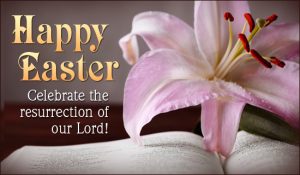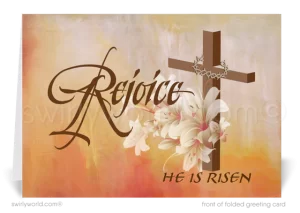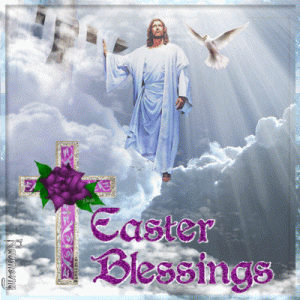 EASTER
EASTER
https://Christianity.com & https://en.wikipedia.org/wiki/Easter
What Is Easter Sunday?
Next to the birth of our Lord and Savior Jesus Christ, Easter Sunday is the most important holiday in Christendom. What is Easter Sunday? Easter Sunday is the day we celebrate the resurrection of Jesus Christ. Jesus Christ is the Son of God. He was crucified and rose three days later. The day that He rose is called Easter Sunday. In the Bible, there is a reference to Easter in The week before Easter, known as Holy Week, is an important time for observers to commemorate the final week of Jesus’ life on earth. The Sunday before Easter is Palm Sunday, with the Wednesday before Easter being known as Spy Wednesday (or Holy Wednesday). The last three days before Easter are Maundy Thursday, Good Friday and Holy Saturday (sometimes referred to as Silent Saturday).
The day and the date that we celebrate Easter was determined in the 7thcentury. Easter is celebrated “on the Sunday following the 14th day of the calendar moon. This comes on or after the vernal equinox fixed for March
Theological significance
A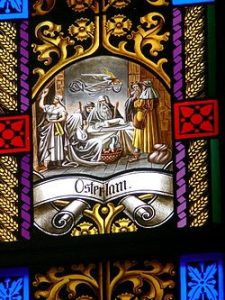 s EASTER tained-glass window depicting the Passover Lamb, a concept integral to the foundation of Easter
s EASTER tained-glass window depicting the Passover Lamb, a concept integral to the foundation of Easter
Easter celebrates Jesus’ supernatural resurrection from the dead, which is one of the chief tenets of the Christian faith. Paul writes that, for those who trust in Jesus’s death and resurrection, “death is swallowed up in victory”. The First Epistle of Peter declares that God has given believers “a new birth into a living hope through the resurrection of Jesus Christ from the dead”. Christian theology holds that, through faith in the working of God, those who follow Jesus are spiritually resurrected with him so that they may walk in a new way of life and receive eternal salvation, and can hope to be physically resurrected to dwell with him in the Kingdom of Heaven.
Easter is linked to Passover and the Exodus from Egypt recorded in the Old Testament through the Last Supper, sufferings, and crucifixion of Jesus that preceded the resurrection. According to the three Synoptic Gospels, Jesus gave the Passover meal a new meaning, as in the upper room during the Last Supper he prepared himself and his disciples for his death. He identified the bread and cup of wine as his body, soon to be sacrificed, and his blood, soon to be shed. The Apostle Paul states in his First Epistle to the Corinthians: “Get rid of the old yeast that you may be a new batch without yeast—as you really are. For Christ, our Passover lamb, has been sacrificed.” This refers to the requirement in Jewish law that Jews eliminate all chametz, or leavening, from their homes in advance of Passover, and to the allegory of Jesus as the Passover lamb.
Western-Eastern divergence
In Western Christianity, using the Gregorian calendar, Easter always falls on a Sunday between 22 March and 25 April, within about seven days after the astronomical full moon. The preceding Friday, Good Friday, and following Monday, Easter Monday, are legal holidays in many countries with predominantly Christian traditions.
Eastern Orthodox Christians use the same rule but base their 21 March according to the Julian calendar. Because of the thirteen-day difference between the calendars from 1900 through 2099, 21 March Julian corresponds to 3 April in the Gregorian calendar (during the 20th and 21st centuries). Consequently, the date of Orthodox Easter varies between 4 April and 8 May in the Gregorian calendar. Orthodox Easter is usually several days or more than a month later than Western Easter.
Western Christianity
Easter and other named days and day ranges around Lent and Easter in Western Christianity, with the fasting days of Lent numbered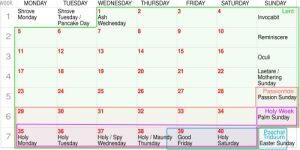
In most branches of Western Christianity, Easter is preceded by Lent, a period of penitence that begins on Ash Wednesday, lasts 40 days (not counting Sundays), and is often marked with fasting. The week before Easter, known as Holy Week, is an important time for observers to commemorate the final week of Jesus’ life on earth. The Sunday before Easter is Palm Sunday, with the Wednesday before Easter being known as Spy Wednesday (or Holy Wednesday). The last three days before Easter are Maundy Thursday, Good Friday and Holy Saturday (sometimes referred to as Silent Saturday).
Palm Sunday, Maundy Thursday and Good Friday respectively commemorate Jesus’s entry in Jerusalem, the Last Supper and the crucifixion. Maundy Thursday, Good Friday, and Holy Saturday are sometimes referred to as the Easter Triduum (Latin for “Three Days”). Many churches begin celebrating Easter late in the evening of Holy Saturday at a service called the Easter Vigil.
The week beginning with Easter Sunday is called Easter Week or the Octave of Easter, and each day is prefaced with “Easter”, e.g. Easter Monday (a public holiday in many countries), Easter Tuesday (a much less widespread public holiday), etc. Easter Saturday is therefore the Saturday after Easter Sunday. The day before Easter is properly called Holy Saturday. Eastertide, or Paschaltide, the season of Easter, begins on Easter Sunday and lasts until the day of Pentecost, seven weeks later.
Liturgical Observance
Christian worshippers attend an Easter Sunday church service at St James’s Church, Piccadilly, London. The cross in the chancel is draped with a white shroud, symbolizing the resurrection.
Western Christianity
The Easter festival is kept in many different ways among Western Christians. The traditional, liturgical observation of Easter, as practiced among Roman Catholics, Lutherans, and some Anglicans begins on the night of Holy Saturday with the Easter Vigil which follows an ancient liturgy involving symbols of light, candles and water and numerous readings from the Old and New Testament.
Services continue on Easter Sunday and in a number of countries on Easter Monday. In parishes of the Moravian Church, as well as some other denominations such as the Methodist Churches, there is a tradition of Easter sunrise services, often starting in cemeteries in remembrance of the biblical narrative in the Gospels, or other places in the open where the sunrise is visible.
In some traditions, Easter services typically begin with the Paschal greeting: “Christ is risen!” The response is: “He is risen indeed. Alleluia!”
Easter Celebrations Around the World
Easter Traditions
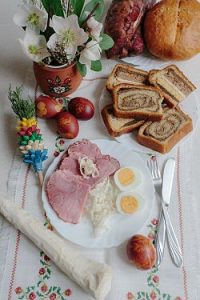 Traditional Slovenian Easter breakfast with eggs, ham with horseradish, and poticaPastel colors are commonly associated with Easter.
Traditional Slovenian Easter breakfast with eggs, ham with horseradish, and poticaPastel colors are commonly associated with Easter.
Easter traditions (also known as Paschal traditions) are customs and practices that are followed in various cultures and communities around the world to celebrate Easter, which is the central feast in Christianity, commemorating the resurrection of Jesus. The Easter season is seen as a time of celebration and feasting, in contrast to the antecedent season of Lent, which is a time of penitence and fasting.
Easter traditions include sunrise services or late-night vigils, exclamations and exchanges of Paschal greetings, flowering the cross, the wearing of Easter bonnets by women, clipping the church, and the decoration and the communal breaking of Easter eggs (a symbol of the empty tomb). The Easter lily, a symbol of the resurrection in Christianity, traditionally decorates the chancel area of churches on this day and for the rest of Eastertide. There are also traditional Easter foods that vary by region and culture. Many traditional Easter games and customs developed, such as egg rolling, egg tapping, and cascarones or confetti eggs. Egg hunting, originating in the idea of searching for the empty tomb, is an activity that remains popular among children. Today Easter is commercially important, seeing wide sales of greeting cards and confectionery such as chocolate Easter eggs.
In countries where Christianity is a state religion, or those with large Christian populations, Easter is often a public holiday. As Easter always falls on a Sunday, many countries in the world also recognize Good Friday and Easter Monday as public holidays. Depending on the country, retail stores, shopping malls and restaurants may be closed on the Friday, Monday or Sunday.
In the Nordic countries, Good Friday, Easter Sunday, and Easter Monday are public holidays, and Good Friday and Easter Monday are bank holidays. In Denmark, Iceland and Norway, Maundy Thursday is also a public holiday; it is a holiday for most workers, except those operating some shopping malls which keep open for a half-day. Many businesses give their employees almost a week off, called Easter break. Schools are closed between Palm Sunday and Easter Monday. According to a 2014 poll, 6 of 10 Norwegians travel during Easter, often to a countryside cottage; 3 of 10 said their typical Easter included skiing. Holy Week in Ruvo di Puglia, Apulia, Italy
Easter in Italy is one of that country’s major holidays. Easter in Italy enters Holy Week with Palm Sunday, Maundy Thursday, Good Friday and Holy Saturday, concluding with Easter Day and Easter Monday. Each day has a special significance. In Italy, both Easter Sunday and Easter Monday are national holidays, which results in a first and a second Easter Sunday, after which the week continues to a Tuesday. Also in the Netherlands, both Easter Sunday and Easter Monday are national holidays, and like first and second Christmas Day, they are both considered Sundays, resulting in a first and a second Easter Sunday, after which the week continues to a Tuesday.
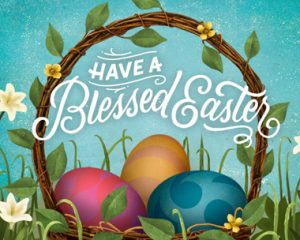 Good Friday and Saturday as well as Easter Sunday and Monday are traditionally observed public holidays in Greece. It is customary for employees of the public sector to receive Easter bonuses as a gift from the state.
Good Friday and Saturday as well as Easter Sunday and Monday are traditionally observed public holidays in Greece. It is customary for employees of the public sector to receive Easter bonuses as a gift from the state.
In Commonwealth nations, Easter Sunday is rarely a public holiday, as is the case for celebrations which fall on a Sunday. In the United Kingdom, both Good Friday and Easter Monday are bank holidays, except in Scotland, where only Good Friday is a bank holiday. In Canada, Easter Monday is a statutory holiday for federal employees. In the Canadian province of Quebec, either Good Friday or Easter Monday are statutory holidays (although most companies give both). In Australia, Easter is associated with harvest time; Good Friday and Easter Monday are public holidays across all states and territories. The Saturday before Easter is a public holiday in every Australian state except Tasmania and Western Australia, while Easter Sunday itself is a public holiday only in New South Wales; Easter Tuesday is additionally a conditional public holiday in Tasmania, varying between award, and was also a public holiday in Victoria until 1994. In New Zealand, Good Friday and Easter Monday are both state holidays.
In the United States, which is a secular country, Easter is not designated as a federal holiday. Easter parades are held in many American cities, though not sponsored by any government, involving festive strolling processions.
Easter eggs
Main article: Easter egg
Traditional customs
The egg is an ancient symbol of new life and rebirth. In Christianity it became associated with Jesus’s crucifixion and resurrection. The custom of the Easter egg originated in the early Christian community of Mesopotamia, who stained eggs red in memory of the blood of Christ, shed at his crucifixion. As such, for Christians, the Easter egg is a symbol of the empty tomb. The oldest tradition is to use dyed chicken eggs.
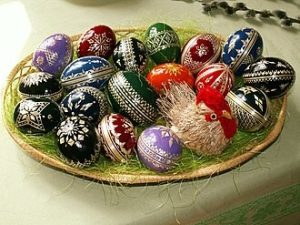 Easter eggs are a widely popular symbol of new life among the Eastern Orthodox but also in folk traditions in Slavic countries and elsewhere. A batik-like decorating process known as pisanka produces intricate, brilliantly colored eggs. The celebrated House of Fabergé workshops created exquisite jewelled Easter eggs for the Russian Imperial family from 1885 to 1916.
Easter eggs are a widely popular symbol of new life among the Eastern Orthodox but also in folk traditions in Slavic countries and elsewhere. A batik-like decorating process known as pisanka produces intricate, brilliantly colored eggs. The celebrated House of Fabergé workshops created exquisite jewelled Easter eggs for the Russian Imperial family from 1885 to 1916.
Modern customs
A modern custom in the Western world is to substitute decorated chocolate, or plastic eggs filled with candy such as jellybeans; as many people give up candy (sweets) as their Lenten sacrifice, individuals indulge in them at Easter after having abstained during the preceding forty days of Lent.
Easter eggs, a symbol of the empty tomb, are popular cultural symbol of Easter.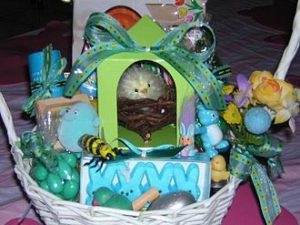
Marshmallow rabbits, candy eggs and other treats in an Easter basket
An Easter egg decorated with the Easter Bunny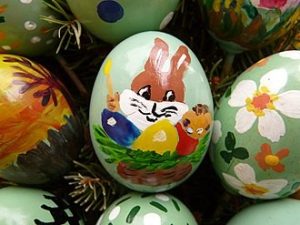
Manufacturing their first Easter egg in 1875, British chocolate company Cadbury sponsors annual egg hunt which takes place in over 250 National Trust locations in the United Kingdom.[199][200] On Easter Monday, the President of the United States holds an annual Easter egg roll on the White House lawn for young children.
Easter Bunny
Main article: Easter Bunny 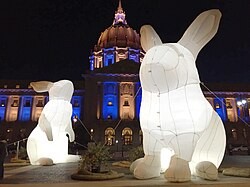
Inflatable Easter Bunny in front of San Francisco City Hall
In some traditions, the children put out their empty baskets for the Easter Bunny to fill while they sleep. They wake to find their baskets filled with candy eggs and other treats. A custom originating in Germany, the Easter Bunny is a popular legendary anthropomorphic Easter gift-giving character analogous to Santa Claus in American culture. Many children around the world follow the tradition of coloring hard-boiled eggs and giving baskets of candy. Historically, foxes, cranes and storks were also sometimes named as the mystical creatures. Since the rabbit is a pest in Australia, the Easter Bilby is available as an alternative.

